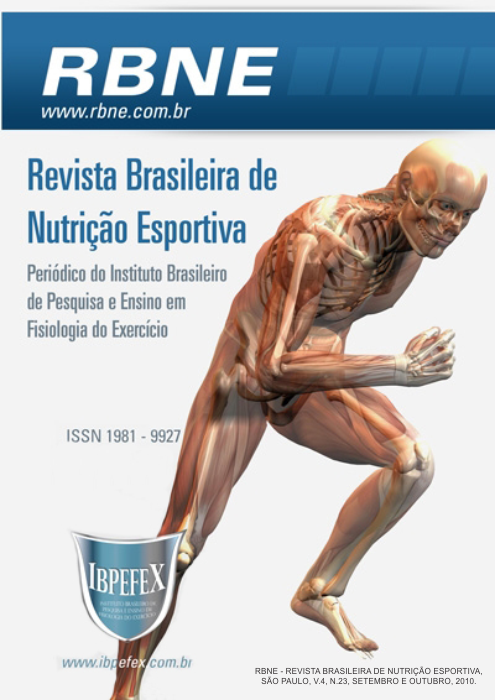Evaluation of consumer protein supplements often a academy between the city of São Paulo
Abstract
The gym is a place for physical exercise by individuals with no professional ties to the sport. The gym environment favors different aesthetic standard stereotypes - lean body, low fat or high volume and muscle tone. Protein intake after hypertrophy exercise promotes increased muscle mass. The Brazilian Society of Sports Medicine, based on the findings of supplement and drug abuse in an environment of physical exercise especially in gyms and health clubs, issued guidelines to intervene the actions and to demystify inadequate attitudes of professionals working in the sport industry. This study examined the consumption of protein supplements by gym members located in the western region of Sao Paulo. These members, eighteen years and older, were surveyed through a questionnaire regarding the use, indication, effectiveness and purpose of consumed supplements. The study found that 32% of individuals use protein supplements, mostly men between 30-40 years of age with a higher education, aiming to gain muscle mass and recovery after a workout. The vast majority were satisfied with the results. Also, the majority of respondents used supplements on the recommendation of friends, physical education professionals or on their own initiative. Thus, greater efforts should be focused on nutritional education to explain the importance and priority of food in a diet and supplementation and adequate indication only when it’s necessary.
References
- Araujo, A.C.M.; Soares, Y.N.G. Perfil de utilização de repositores protéicos nas academias de Belém, Pará. Rev. Nutr., Campinas, Vol. 12. Num. 1, Apr. 1999.
- Coelho, C.F.; Camargo, V.R.; Ravagnani, F.C.P. Consumo de suplementos nutricionais por praticantes de musculação em academias de Campo Grande-MS. Nutrição em Pauta, Ano. 15. Num. 87. p.41-45, Nov/dez 2007.
- Fernandes, C.; Gomes, J.M.; Navarro, F. Utilização de suplementos por praticantes de atividade física na Cidade de São Paulo e Região. Revista Brasileira de Nutrição Esportiva, São Paulo. Vol. 3. Num. 13. Janeiro/Fevereiro, 2009. p. 05-12.
- Ferreira, C.F.S.; Belli, F.; Raggio, W.C.S.; Navarro, F. Uso de Suplementos Nutricionais por Adolescentes em Academias do Interior e de São Paulo Capital. Revista Brasileira de Nutrição Esportiva, São Paulo. Vol. 2. Num. 10. Julho/Agosto, 2008. p. 154-165.
- Haraguchi, F.K.; Abreu, W.C.; Paula, H. Proteínas do soro do leite: composição, propriedades nutricionais, implicações no esporte e benefícios para a saúde humana. Rev. Nutr. [online]. Vol. 19. Num. 4. 2006. p. 479-488.
- Hernandez, A.J.; Nahas, R.M. Diretriz 2009: Modificações dietéticas, reposição hídrica, suplementos alimentares e drogas: comprovação de ação ergogênica e potenciais riscos para a saúde. Suplemento – Rev Bras Med Esporte. Vol. 15. Num. 2. Mar/Abr, 2009. p. 12.
- Hirschbruch, M.D.; Fisberg, M.; Mochizuki, L. Consumo de Suplementos por Jovens Freqüentadores de Academias de Ginástica em São Paulo; Rev Bras Med Esporte. Vol. 14. Num. 6. Nov/Dez, 2008.
- Machado, D.Z.; Schneider, A.P. Consumo de suplementos alimentares em freqüentadores de uma academia de ginástica de Porto Alegre – Rio Grande do Sul. Nutrição em Pauta. p.13-17. 2006.
- Pereira, I.C.; Souza, I.R.D.; Lisboa, M.F. Perfil Alimentar de Praticantes de Musculação na Maturidade. Revista Brasileira de Nutrição Esportiva, São Paulo. Vol. 1. Num. 1. Jan/Fev, 2007. p. 54-59.
- Pereira, R.F.; Lajolo, F.M.; Hirschbruch, M.D. Consumo de Suplementos por alunos de academias de ginástica em São Paulo. Revista de Nutrição, Campinas. Vol. 16. Num. 3. jul/set.,2003. p. 265-272.
- Position of the American Dietetic Association: functional foods. J Am Diet Assoc. Num.99. 1999. p. 1278-1285.
- Santos, M.A.A.; Santos, R.P. Uso de suplementos alimentares como forma de melhorar performance nos programas de atividade física em academias de ginástica. Rev. paul. Educ. Fís. Vol. 16. Num. 2. 2002. p. 174-185.
Authors who publish in this journal agree to the following terms:
- Authors retain the copyright and grant the journal the right of first publication, with work simultaneously licensed under the Creative Commons Attribution License BY-NC which allows the sharing of the work with acknowledgment of the authorship of the work and initial publication in this journal.
- Authors are authorized to enter into additional contracts separately for non-exclusive distribution of the version of the work published in this journal (eg, publishing in institutional repository or book chapter), with acknowledgment of authorship and initial publication in this journal.
- Authors are allowed and encouraged to post and distribute their work online (eg, in institutional repositories or on their personal page) at any point before or during the editorial process, as this can bring about productive change as well as increase impact and impact. citation of published work (See The Effect of Free Access).






